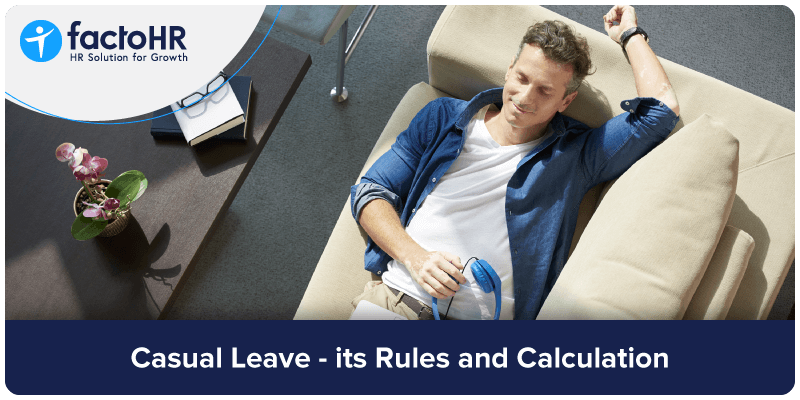Casual Leave - its Rules and Calculation

Table of Contents
There are various types of leaves available for employees as per the governing laws and regulations established by the government. Organisations are expected to follow the laws and provide minimum stipulated leaves under various categories. Organisations have their leave policies framed keeping these laws in mind. Many also try to exceed the limits and provide the best possible outcomes to their employees in a view to retaining and attracting top talent.

Meaning of Casual Leave
Casual leave refers to the paid leave granted to employees for personal reasons, which are not covered under other types of leave such as sick leave, earned leave, or maternity leave. It is also known as CL or casual/casuals.
Organisations may differ in the number of casual leave days granted to employees. Casual leaves are usually a small percentage of the total number of privilege leaves the employee is entitled to as of that date. Casual leaves are not usually rolled over to the next year and they just lapse if they are not utilised.
Some common examples of situations where an employee may use casual leave in India include:
Personal or family exigencies
This is one of the key reasons that casual leave exists. An unplanned event or an emergency can be attended to without worrying about loss of pay.
Attending personal appointments
Since casual leave can be taken for a few hours or half a day or more, it comes in handy to attend to those tasks that have to be completed during business hours. A doctor’s appointment, a visit to the bank or a parent-teacher meeting in school cannot wait for the weekends.
Celebrating a special occasion
Those occasions like birthdays, anniversaries or festivals are best celebrated on the actual calendar day than waiting for a weekend.
Simply taking a break
Sometimes you just need a break from it all. Many employees feel the need for taking a break after they have completed a major project to rejuvenate. Taking such breaks helps both the employee and the employer.
Casual leave is generally granted subject to the company’s policies and procedures and at the discretion of the employer. It is both professional courtesy and at times the policy too for the employees to provide prior notice to their managers and/or HR department when requesting casual leave. On occasions like a family emergency, the employer may not be able to either provide advance notice or take prior approval. However, companies do allow applying for the leave after returning to work.
Read about Creating an Effective and Compliant Leave Policy for SMEs here.

What are the rules that govern casual leaves?
Casual leave policies may vary between organisations. Here are some of the common rules and guidelines around casual leave:
Eligibility
Organisations define eligibility in their leave policy document. Most organisations use the length of the employee service in the organisation and the type of employment to determine eligibility. Most contract employees are not usually eligible for this leave.
Accumulation
Casual leave is not treated as earned leave and as such organisations do not allow for accumulating these leaves or rolling them over to the next year.
Maximum limit
Most employers set a maximum limit on the number of days that an employee can take as casual leave in a year or per occasion.
Approval process
Employees are usually expected to seek prior approval from their supervisor or manager before taking casual leave.
Advance notice
Giving advance notice before taking casual leave is the recommended process. This facilitates the process of planning ahead to provide cover for the employee. The rest of the team, with the help of their supervisor, can plan and ensure there is sufficient coverage during the employee’s absence.
Pay
Casual leave is paid leave and the employees continue to receive their salary during their absence.
It is important for employees to understand their organisation’s policies and guidelines around casual leave to avoid any confusion or misunderstandings.
Rules for government employees
Casual leave policies for central government and state government employees in India are governed by separate sets of rules and regulations. Here is an overview of the rules around casual leave for central government and state government employees:
Central Government Employees
Central government employees are covered under the Central Civil Services (Leave) Rules, 1972, which provides for different types of leave including casual leave. Here are the key rules around casual leave for central government employees:
Eligibility
All permanent and temporary employees are eligible for casual leave.
Accumulation
A maximum of 8 days of casual leave can be accumulated in a calendar year.
Maximum limit
Employees can avail of up to 8 days of casual leave in a calendar year.
Approval process
Prior approval of the appropriate authority is required for availing of casual leave.
Notice period
Employees are required to give prior notice to their supervisor or reporting officer before availing of casual leave.
Pay and benefits
Casual leave is considered as paid leave and employees continue to receive their salary during their absence. However, no special allowance is admissible during casual leave.
State Government Employees
State government employees are governed by the leave rules of their respective state governments. However, most state governments have adopted the Central Civil Services (Leave) Rules, 1972 as the basis for their own leave rules. Here are some of the common rules around casual leave for state government employees:
Eligibility
All permanent and temporary employees are eligible for casual leave.
Accumulation
A maximum of 12 days of casual leave can be accumulated in a calendar year.
Maximum limit
Employees can avail of up to 12 days of casual leave in a calendar year.
Approval process
Prior approval of the appropriate authority is required for availing of casual leave.
Notice period
Employees are required to give prior notice to their supervisor or reporting officer before availing of casual leave.
Pay and benefits
Casual leave is considered as paid leave and employees continue to receive their salary during their absence. However, no special allowance is admissible during casual leave.
Central and state government employees should always refer to the latest guidelines before availing of casual leave as the rules are subject to change.

Conclusion
Casual leaves are just that – unplanned and do not fall into the rest of the leave categories! These types of leaves help employees to overcome unavoidable and unplanned absences from work. These are paid leaves and hence are counted as benefits to the employee.
Grow your business with factoHR today
Focus on the significant decision-making tasks, transfer all your common repetitive HR tasks to factoHR and see the things falling into their place.

© 2025 Copyright factoHR


